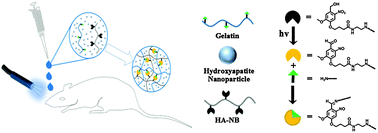An in situ phototriggered-imine-crosslink composite hydrogel for bone defect repair
Abstract
A novel in situ phototriggered-imine-crosslink (PIC) three-component biomimetic composite hydrogel, which was composed of hyaluronic acid (HA), gelatin, and hydroxyapatite nanoparticles (n-HAps), was successfully prepared in this study. o-Nitrobenzyl derivative NB was grafted to HA (HA-NB). Upon 365 nm light irradiation, o-nitrosobenzaldehydes were photo-generated and subsequently reacted with amino-bearing gelatin to build a hydrogel via imine ligation (HA-NB/gelatin/n-HAp). SEM showed that n-HAps could uniformly disperse in the HA-NB/gelatin hydrogel structure. Rheological analysis revealed that the composite hydrogel exhibited good light-sensitivity. The hydrogel was also biocompatible and demonstrated the ability to stimulate the osteogenesis of encapsulated hBMSCs attributed to n-HAps. Moreover, the osteogenic capacity was evaluated by means of applying the composite hydrogel in a critical-sized calvarial defect model of rats for 8 weeks. As indicated by micro-CT, sequential fluorescent labeling and histological analyses, newly formed bone was significantly enhanced in the composite hydrogel group. These data indicated that the phototriggered-imine-crosslink HA-NB/gelatin/n-HAp hydrogel can be used as a promising strategy for bone defect repair applications.


 Please wait while we load your content...
Please wait while we load your content...